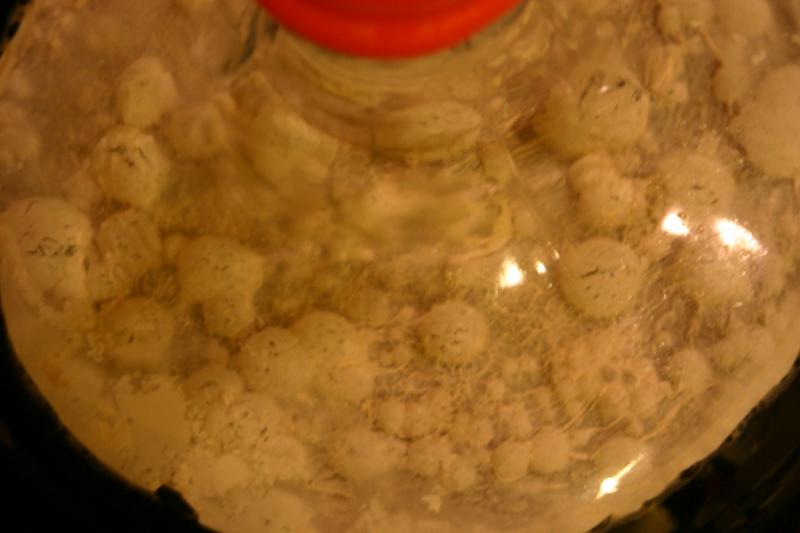You are using an out of date browser. It may not display this or other websites correctly.
You should upgrade or use an alternative browser.
You should upgrade or use an alternative browser.
What is this infected with and can I turn it into something worth drinking??
- Thread starter bierbrauer
- Start date

Help Support Homebrew Talk - Beer, Wine, Mead, & Cider Brewing Discussion Forum:
This site may earn a commission from merchant affiliate
links, including eBay, Amazon, and others.
electric_beer
Well-Known Member
Do you have a better picture? From what I can tell looks like it just stirred up your yeast and reactivated it a bit. Although I can't tell if there are any weird penicile type growths.
avidhomebrewer
Well-Known Member
- Joined
- Sep 28, 2007
- Messages
- 2,553
- Reaction score
- 28
It doesn't look like anything but yeast, like electric said.
Same here, it looks like a new krausen to me. Are you sure the beer was finished before you moved it to secondary?
ryane
Well-Known Member
Although I can't tell if there are any weird penicile type growths.
good god man! i hope none of my beers ever have any penicile growths anywhere near them

ChrisKennedy
Well-Known Member
That definitely looks infected to me. Brett would be a reasonable guess.
The pizza bubbles and veins over the skin are a pretty good give away.
I would either drink it as fast as you can if it still tastes good, or if you don't need the carboy, let it sit for a couple of months. If you need the carboy, just dump it and start again after taking a good long look at your sanitation practices.
The pizza bubbles and veins over the skin are a pretty good give away.
I would either drink it as fast as you can if it still tastes good, or if you don't need the carboy, let it sit for a couple of months. If you need the carboy, just dump it and start again after taking a good long look at your sanitation practices.
Shrewd_Alchemist
Well-Known Member
That's no krausen.... the beer itself is pretty still and clear.
Take a whiff and possibly even a taste test! I've seen lambics that look far worse than that and people actually like them
Take a whiff and possibly even a taste test! I've seen lambics that look far worse than that and people actually like them
bierbrauer
Well-Known Member
Taste test reveals a hoppy pale ale. Whether this will change over time remains to be seen. For now I think I will have to drink half of it and stick the other carboy in a dark corner for a few months to see what transpires. If I get a better picture I will post it again.
bierbrauer
Well-Known Member
HEre is an updated picture of my infection. Anyone know what it might be??




electric_beer
Well-Known Member
Have you tasted a sample at all or sniffed the airlock?
JetSmooth
Well-Known Member
Pivzavod
Well-Known Member
Its not Brett, its some wild bacteria that got into your equipment or possibly mutated yeast.
Here is a pic of what I've had in the past:

Here is what someone else had:

I just kegged a batch of a Saison and had similar stuff on top of it. This is why I think it might be coming from yeast. Mine was washed and previous batches had similar growth but did not cause any problems to the flavor of the beer.
Here is a pic of what I've had in the past:

Here is what someone else had:

I just kegged a batch of a Saison and had similar stuff on top of it. This is why I think it might be coming from yeast. Mine was washed and previous batches had similar growth but did not cause any problems to the flavor of the beer.
Looks like Brett to me, which is a yeast.
Pivzavod
Well-Known Member
Brett takes a long time to become active:
(3 to 7 days) Enteric Bacteria and Kloeckera Apiculata
(2 weeks) Saccharomyces
(3 to 4 months) Lactic Acid Bacteria
(8 months) Brettanomyces plus Pichia, Candida, Hansenula and Cryptococcus
In the few cases of me having this I had it after 2.5-3 weeks in primary.
(3 to 7 days) Enteric Bacteria and Kloeckera Apiculata
(2 weeks) Saccharomyces
(3 to 4 months) Lactic Acid Bacteria
(8 months) Brettanomyces plus Pichia, Candida, Hansenula and Cryptococcus
In the few cases of me having this I had it after 2.5-3 weeks in primary.
ChrisKennedy
Well-Known Member
Brett takes a long time to become active:
(3 to 7 days) Enteric Bacteria and Kloeckera Apiculata
(2 weeks) Saccharomyces
(3 to 4 months) Lactic Acid Bacteria
(8 months) Brettanomyces plus Pichia, Candida, Hansenula and Cryptococcus
In the few cases of me having this I had it after 2.5-3 weeks in primary.
You are applying that Sparrow chart too narrowly. He is talking very generally about the order of microbiological functioning in lambics.
Brett can most certainly become active immediately, given the right sort of environment and infection/innoculation.
Pivzavod
Well-Known Member
You are applying that Sparrow chart too narrowly. He is talking very generally about the order of microbiological functioning in lambics.
Brett can most certainly become active immediately, given the right sort of environment and infection/innoculation.
If Brett becomes active doesnt it need a long time to produce any of the flavors associated with it (barnyard, horsey, etc)?
SumnerH
Well-Known Member
If Brett becomes active doesnt it need a long time to produce any of the flavors associated with it (barnyard, horsey, etc)?
Orval is something like 2 months from brew day to going out to retail, and the brett isn't added until a reasonable way into the process. It definitely gets "brettier" with age, but there's a reasonable amount of brett flavor right out of the gate.
ChrisKennedy
Well-Known Member
If Brett becomes active doesnt it need a long time to produce any of the flavors associated with it (barnyard, horsey, etc)?
Depends on a ton of factors, sugar supply, oxygen, brett pitching rate, kind of brett, nutrients available to it, etc.
Frankfurtvr4
Well-Known Member
This is what I know. I was eating lunch and now I am not anymore. GROSS!
Pivzavod
Well-Known Member
In my case it always appeared late in the fermentation (2.5+ weeks). I guess there wasnt much sugars left, brett was not pitched directly and very low amount of oxygen due to the fermentor being closed from day 1.
This looks similar to whats in my cider now. I used apple juice and wild yeast from fresh-picked, unwashed berries. It appeared as soon as active fermentation slowed down. Im hoping its either Brett or malo-lactic fermentation.
Eric
Eric
bierbrauer
Well-Known Member
I am just going to hold onto them for now and do periodic tasting to see what kind of funky juice will come out if this in the end!!!
I had a pellicle like this form on top of a roggenbier while it was in the primary. I pasteurized the beer by heating it covered to 160F, holding for 20 min, and letting it cool. The pellicle didn't come back and I bottled it. Not going to touch it for months, and I'm hoping the smell gets better.
oldschool
Well-Known Member
I had an infection like that. It showed up in the primary and tasted fine so I went ahead an bottled. The pellicle reappeared in the bottles and eventually became evident/bad in the taste. I pitched all the bottles 7 months after bottling when one exploded.
Its not Brett, its some wild bacteria that got into your equipment or possibly mutated yeast.
Here is a pic of what I've had in the past:

Here is what someone else had:

I just kegged a batch of a Saison and had similar stuff on top of it. This is why I think it might be coming from yeast. Mine was washed and previous batches had similar growth but did not cause any problems to the flavor of the beer.
Hey I recognize that infection...that's from my fermenter!
Brewdouche-RuBrew
Well-Known Member
You have 3 choices, I will list them in order of effectivness, and hassel.
choice #1-100% effective. Dump, cry, start over.
choice #2-Buy some...gasp... Potasium or sodium metabisulfite... used in wine making to sanitize raw fruit of wild yeast & bacteria. Follow directions. I'll say 97% effective if its wild yeast or bacteria, 75% if its mold. It doesnt look like a fungi though.
Choice #3-99% see below, and look up pasturization.
choice #1-100% effective. Dump, cry, start over.
choice #2-Buy some...gasp... Potasium or sodium metabisulfite... used in wine making to sanitize raw fruit of wild yeast & bacteria. Follow directions. I'll say 97% effective if its wild yeast or bacteria, 75% if its mold. It doesnt look like a fungi though.
Choice #3-99% see below, and look up pasturization.
... I pasteurized the beer by heating it covered to 160F, holding for 20 min, and letting it cool. ...
Similar threads
- Replies
- 11
- Views
- 1K
- Replies
- 10
- Views
- 517
- Replies
- 4
- Views
- 467

